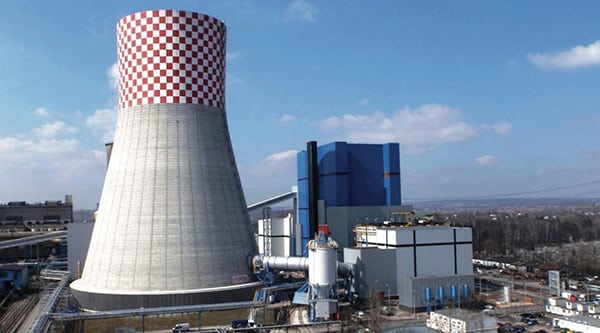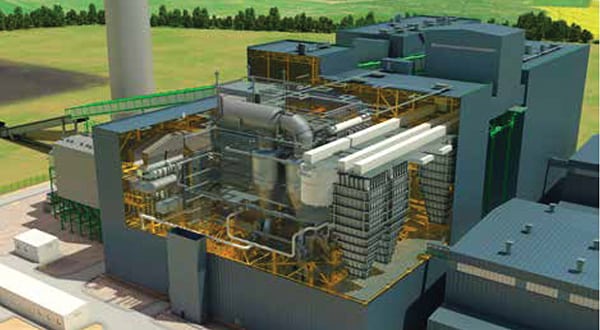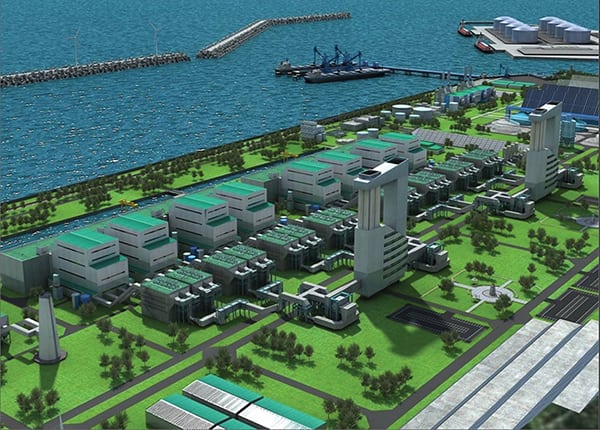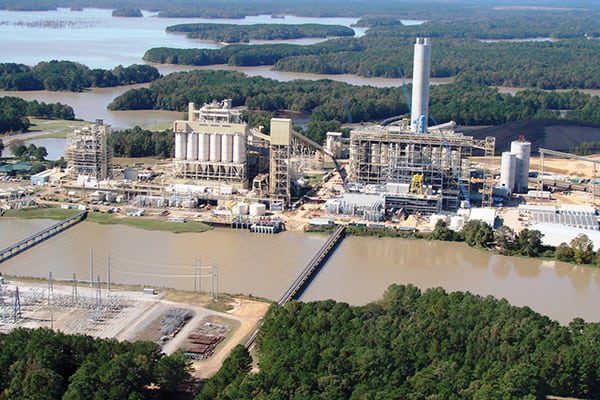Fuel-Flexible CFBs Add Flexibility to Resource Plans
The downward trend in solid fuel quality has negatively affected many power generators that rely on imported fuels. For others, this represents a market opportunity. A quick survey of recent installations found that fuel-flexible circulating fluidized bed (CFB) boilers addressed owners’ fuel source concerns by efficiently burning low-quality, high-moisture coals, even when mixed with biomass and other opportunity fuels.
Coal has fueled the generation of 41% of the world’s electricity demand in the 21st century thus far, according to a fact sheet released by the World Coal Association last December. You may be surprised to learn that the amount of coal used globally has grown each year since 2000, and coal continues to be the world’s favorite and fasting growing fuel. New coal-fueled power generation facility capacity installed since 2000 exceeds the capacity of new generation by nuclear, oil, gas, and renewables combined. In fact, coal is expected to overtake oil as the world’s main source of energy for power production by 2020.
Coal will likely remain the dominant fuel for some time, as global electricity demand is expected to double over the next three decades, particularly in regions experiencing electricity poverty. For example, coal-fueled generation has played a vital role in providing electricity to more than 450 million people in China in the past 15 years. Another 1.4 billion people remain without access to electricity, and coal will be the likely fuel source for many future electrification projects.
Developed countries’ demand growth remains stagnant, and the focus is on energy efficiency, emissions reductions, and greater use of less-carbon-intense biomass fuels. However, economic development and the eradication of poverty remain the primary concerns of two-thirds of the world, and that means significant demand growth and the burning of more coal and indigenous biomass fuels.
Lower-Quality Fuels Abound
Regional disparities in coal quality have materialized as global coal use grows. Very attractive price discounts and growing supplies of lower-quality Indonesian and domestic coals are outpacing the supply of imported high-quality Australian, Russian, and U.S. coals. This downward trend in coal quality is of interest to power plant developers in terms of available coal quantities, particularly for plants designed around conventional pulverized coal (PC) boilers, as PC boilers generally prefer coal with a heating value over 5,500 kcal/kg.
Indonesia, with coal exports exceeding 400 million metric tons in 2013, is the largest coal exporter in the world, with twice the exports of Australia, its nearest competitor. Today about 50% of Indonesian coal exports are low-quality high-moisture subbituminous coal with gross higher heating values (HHV) between 3,900 kcal/kg and 4,200 kcal/kg, well below the historical benchmark of 6,000 kcal/kg used in the international coal market for the past 50 years.
These lower-quality coals have created a market advantage for generators that can burn less-energy-intensive coals, because the price is discounted, on a Btu basis, about 25%. Because the cost of fuel represents about 80% to 85% of the cost of operation, the ability to burn a lower-quality coal (without affecting plant operations and maintenance costs) has a dramatic effect on a plant’s wholesale cost of electricity.
Cofiring coal with biomass is another way to gain fuel flexibility, though it does add complexity to the fuel supply equation.
Biomass is a generic term that describes a range of organic mixtures, ranging from clean wood chips produced from harvested trees to agricultural residue (agro, such as some straws, olive, and rapeseed), salvaged wet forest residues, and manufacturing wood waste. Biomass properties vary considerably, depending on their biological and regional origin, seasonality, farming and harvesting practices, and ultimately on their preparation and processing. This leads to broad variations in chemical composition and physical properties across different biomass types and even within the same source type. These wide property differences are one of the key challenges of using biomass as a fuel for power and steam production. (For more on the challenges and advantages of using biomass, see “Utility Biomass Use: Turning Over a New Leaf?” in this issue.)
Each of these fuels often causes difficulties when cofired, such as agglomeration, fouling, and corrosion of boiler convective heat surfaces. These problems can usually be traced back to elevated concentrations of alkali, phosphorous, and chlorine, which are typically much higher in most agricultural products than in wood waste.
PC boilers also are particularly sensitive to the unpredictable fuel heat content experienced when burning ever-changing mixes of biomass fuels. CFB boilers, in contrast, are particularly effective when burning a combination of waste biomass and can even fire 20% to 30% of difficult agro biomass with coal and up to 100% of other forms of waste biomass. The maximum size of a CFB plant designed for cofiring large amounts of biomass with coal appears to be about 600 MW today.
In addition to inherent fuel flexibility, CFB boilers enjoy a flameless, low-temperature combustion process (~850C versus ~1,500C for a PC boiler) that does not melt or soften the ash formed, as does a conventional boiler with an open flame. In many regions, the lower combustion temperature of the CFB design plus the capability to add limestone directly into the furnace bed eliminates the requirement for separate NOx and SO2 removal equipment. Eliminating the external air quality control systems could save $150 million to $200 million in capital cost on a 600-MW project.
These design differences can also have a significant effect on plant availability. Data from the European Union on bituminous coal–, brown coal–, and lignite-fired utility-scale CFB plants show that plant availability for CFB plants was about five points higher than for PC installations. Those five points of increased plant availability will produce fuel savings of about $100 million for a baseload plant over 10 years at today’s fuel and wholesale electricity prices.
Flexible Fuel Projects
Different plant developers have responded to the challenge of building fuel-flexible power plants in different ways. The rest of this article profiles seven CFB plants that cofire solid fuels, are of utility-scale (>50 MW), and have either recently been constructed or are in the process of being constructed. Each plant design is unique and reflects the fuel supply and electricity markets of its particular region. Several are touted as “the world’s largest….” Others are interesting because of their fuel mix.
Lagisza Power Station, Poland. The Lagisza power plant in southern Poland operates the world’s largest CFB boiler (Figure 1). Owned by Tauron Wytwarzanie S.A., the 460-MW plant was commissioned in June 2009. The CFB boiler burns fuels ranging from low-rank to high-rank coals, plus biomass and waste coal slurries.
Lagisza has many unique first-of-a-kind design features, including vertical-tube supercritical steam technology and low-temperature flue gas heat extraction that explains how the plant achieves a very high 43% net lower heating value (LHV) thermal efficiency. The efficient performance of the CFB also produces less air emissions. Lagisza meets all its air emission permit levels without any postcombustion de-NOx or de-SOx equipment, such as a selective catalytic reduction (SCR) or separate flue gas desulfurization system.
The Foster Wheeler AG (FW) CFB’s load-following capability is another important feature for grids experiencing increasing amounts of intermittent renewable power. In fact, Lagisza enjoys the same load ramp as an equivalently sized PC boiler, but it has a much better turndown. Lagisza cycles from about 40% to 100% of full-load rating each day to meet the requirements of the Polish National Grid.
Konin Power Plant, Poland. In July 2009, ZE PAK SA signed a contract for the turnkey construction of a 55-MW biomass-fired CFB boiler at its Konin Power Plant, the oldest generating plant within ZE PAK SA. The plant is also the supplier of space heating for the town of Konin and surrounding areas. Construction began in February 2010, and the unit was commissioned in July 2012 (Figure 2). With completion of the new unit, the Konin Power Plant now consists of six cross-connected boilers interconnected with its three steam turbines plus the CFB boiler.
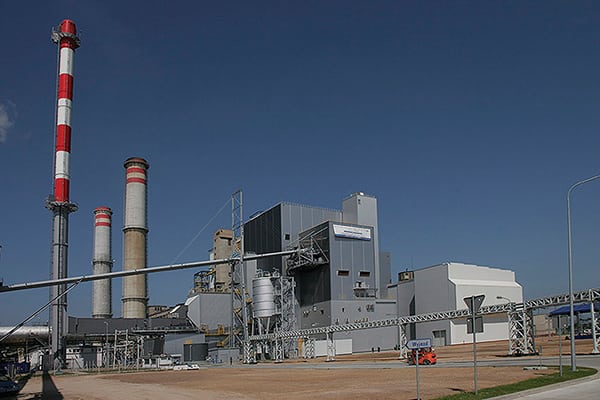 |
| 2. Multifuel boiler. One of the primary advantages of the CFB is its ability to handle a range of biomass fuels without problem. Courtesy: ZE PAK SA |
Although much smaller than Lagisza, Konin is unique (Figure 3). Its CFB boiler is a state-of-the-art biomass-fired unit designed for burning clean, woody biomass and up to 20% of agricultural biomass including willow, straw, rapeseed residue, cherry stones, and oat husk. The boiler design consists of the furnace and two high-efficiency solid separators that capture unburned material entrained in the boiler exhaust gas and recycle the material back to the furnace. The result is much-improved combustion efficiency and fewer emissions. The guaranteed boiler efficiency was 91% with guaranteed emissions of 200 mg/Nm3 NOx and 200 mg/Nm3 SOx.
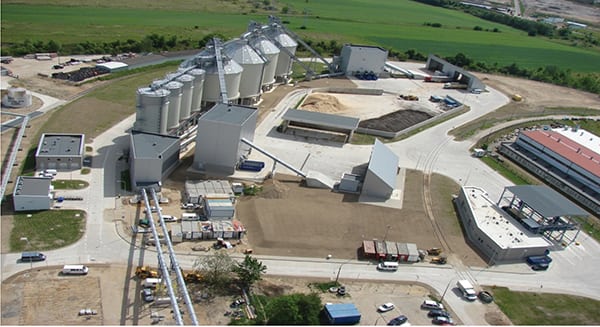 |
| 3. Many biomass mixes. The Konin Power Plant was designed to handle a wide range of biomass fuels. Courtesy: Foster Wheeler |
A variety of biomass is transported by trucks to the plant unloading station and conveyed to silos in the storage yard. There are three separate storage silos, each dedicated to forest and woody biomass, and five separate silos for agro biomass. Each agro fuel is fed from its own silo, as the fuel mixture consists of straw pellets, oat husk, cherry stones, rapeseed cake, and energy willow.
The system allows the dosing of different types of biomass using screw conveyors in order to feed a homogenous fuel mixture to the boiler fuel silos. The mixture of different types of biomass is distributed evenly to the CFB boiler by four feeding points. The fuel is fed to solid return chutes from external integrated heat exchangers and mixed with circulating material before entering the furnace.
Polaniec Power Station, Poland. GDF Suez Energia Polska SA’s 1,800-MW coal-fired Polaniec Power Station is the fifth-largest power plant in Poland (Figure 4). It consists of eight units, each with a capacity of 225 MW, built between 1979 and 1983.
 |
| 4. Pure biomass burning. The Polaniec Green Unit, at 205 MW, claims to be the largest 100% biomass-fired power plant in the world. Courtesy: Petr Štefek |
In April 2010, GDF Suez Energia began construction of the world’s largest CFB boiler designed to fire 100% biomass at its Polaniec plant site, and the plant—known as the Polaniec Green Unit (a POWER renewable Top Plant, see the December 2013 issue)—was commissioned on Nov. 15, 2012.
The FW Advanced Bio CFB combustion technology was selected for the plant that now produces 205 MW using a broad range of biomass fuels. The wood and agro biomass fuel is composed of 80% wood and 20% agro biomass. The wood portion is clean wood from forestry residues. The agro portion includes a variety of agricultural biomass such as straw, sunflower pellets, dried fruit, and palm kernel shell.
The boiler is equipped with an ammonia injection system and catalyst—selective noncatalytic reduction (SNCR) plus SCR—for controlling NOx emissions, and an electrostatic precipitator for controlling particulate emissions. Boiler steam conditions are 127 bar and 535C. Emissions guarantees, based on a 24-hour average, are 150 mg/Nm3 NOx, 150 mg/Nm3 SO2, and 50 mg/Nm3 CO.
The boiler has operated well with various fuel mixes and continues to operate with high efficiency. Boiler operation responds to requirements of electricity production, and full load range is in use on a weekly basis. The boiler fulfills all Polish grid requirements with a 4% minimum load change rate demonstrated solely with solid biomass fuels with a turndown to 40% of design load.
Narva Elektrijaamad AS, Estonia. Alstom is constructing a 300-MW CFB boiler plant for Narva Elektrijaamad AS (affiliate of Eesti Energia), located near the Russian border in Estonia (Figure 5). The Eesti Power Plant, built between 1963 and 1973, was originally constructed with 16 boilers and eight 200-MW steam turbines. Eesti was selected as the site for the utility’s new fuel-flexible CFB boiler that is designed to burn low-heat-content fuel mixtures of oil shale (8.2 MJ/kg), peat (8.75 MJ/kg), and up to 50% cofiring of wet wood chips (50% water by weight, 8.35 MJ/kg), all LHV.
The unique combination of fuels has an unexpected benefit. The inherent calcium content of the oil shale facilitates high natural sulfur removal, and the 200 mg/Nm3 limit on SO2 emissions will be met without adding additional limestone to the CFB furnace.
The low combustion temperature of the CFB furnace also produces less than the NOx limit of 150 mg/Nm3 without an additional denitrification system despite the high NOx emissions produced when combusting peat. An electrostatic precipitator removes the particulate emissions from the stack gas. Alstom guaranteed a boiler efficiency of 92.3% (LHV) based on a steam pressure of 178 bar and superheat/reheat steam temperatures of 543C/568C. The plant is scheduled to enter commercial service in October 2015.
Samcheok Green Power Plant, South Korea. Korean Southern Power Co. (KOSPO) also concluded that fuel procurement flexibility would save the company millions of dollars in fuel costs over its new plant’s life. KOSPO selected CFB technology for its 2,200-MW Green Power Plant project, perhaps one of the most ambitious power projects ever undertaken in South Korea. KOSPO describes the project as the most efficient and greenest coal plant ever built. When completed (expected by 2020), the facility will house 5,000 MW of power generation, including renewable energy projects (Figure 6).
The Samcheok plant is located in Gangwon-do Province in northeast South Korea on 2.5 million square meters of reclaimed coastal land. Now under construction, the first phase uses four 550-MW FW CFBs featuring the world’s first CFB boilers operating at ultra-supercritical steam conditions (257 barg, 603C/603C), which is a scale-up of the Lagisza plant design. The CFBs will be the most advanced CFB boiler units in the world when the plant enters commercial service—scheduled for July 2015. Foster Wheeler was given a full release for the project in July 2011.
The following project phase is planned to include approximately 1,000 MW produced from renewable resources such as wind turbines, solar panels, wave power generation, and small hydropower generation. When completed, the entire facility is expected to cost $3 billion.
The plant will burn high-moisture Indonesia coal and biomass with a net plant heat rate of 8,800 Btu/kWh (HHV), although the plant is expected to initially burn Indonesian subbituminous coal and some petroleum coke.
The Korean Renewable Portfolio Standard provides many incentives for burning biomass, so the plant is designed to burn up to 20% biomass, a total of about 400 MW. KOSPO CEO Lee Sang-ho noted in an interview with the Korea Herald in late 2013, “CFB steam generators can maximize efficiency of coal-powered power plants as they can be run based on cheap, low-grade coal.” Lee added, “low-grade coal was about 50 percent cheaper than high grade coal.” That makes a big difference, as Korea must import all its coal used for power generation.
Cleco’s Madison Unit 3, U.S. In the U.S., CFB boiler technology has proven its ability to efficiently, cleanly, and reliably convert petcoke, a waste product produced by petroleum refineries, into electricity. The largest operating petcoke-fired power plant in the world is Cleco’s 600-MW Madison Unit 3 (Figure 7), located in central Louisiana. (See the August 2010 issue at powermag.com for an in-depth description of the plant.)
Cleco selected CFB technology so that it has “the capability to use multiple solid fuels, including biomass [to] help us lower customer fuel costs.” Petroleum coke is much less expensive than the alternative fuels available in this region, and a fraction of the cost of western subbituminous coal delivered to the plant site. Cleco believes that over 30 years, the use of petcoke will save its customers several billion dollars in fuel purchases. The unit consumes approximately 1.5 million tons of petcoke each year.
Fuel is delivered to the plant site from the Gulf Coast via barge moving along Louisiana’s Mississippi and Red Rivers. The site already had access to waterborne transportation from the Gulf Coast. The petcoke is unloaded onto a 1.5-mile-long conveyor that moves the solid fuel to the plant for storage.
The reclaimed petcoke is crushed to about ¼-inch, mixed with crushed limestone, and gravimetrically metered as it is injected into the CFB furnace. The limestone removes about 90% of the SO2 formed in the combustion process. Aqueous ammonia is injected to further reduce the NOx produced in the CFB. A polishing dry scrubber absorbs additional SO2, and a baghouse removes particulates from the stack gas.
Madison Unit 3’s boiler operates at subcritical steam conditions. The steam pressure is 2,550 psig, and steam temperatures are 1,050F/1,050F. NOx production is limited to 0.07 lb/MMBtu and SO2 is limited to 0.15 lb/MMBtu, which represents a 99% removal rate.
EKPC’s Hugh L. Spurlock Generating Station 4, U.S. East Kentucky Power Cooperative’s (EKPC’s) Spurlock Station 4, located in Maysville, Ky., entered commercial operation in 2009 (Figure 8). Alstom supplied the boiler island for Station 4, which included the CFB, SNCR for NOx control, and its flash dryer absorber or NID system, which is designed to remove 95% of SO2 emissions regardless of the sulfur content of the fuel. The unit reduces limestone consumption by about 25% by reactivation of free lime in the NID system.
 |
| 8. Fuel buffet The Hugh L. Spurlock Generating Station 4 is designed to cofire a wide range of solid fuels with West Kentucky coal, including petcoke, biomass, and waste tires. Courtesy: Alstom |
The CFB boiler is designed to fire a wide range of coals as well as enable up to 20% cofiring of petcoke, biomass, and approximately five million tires per year. The boiler steam conditions are 174 bar and 541C/541C. The design coal is Western Kentucky coal with a heating value of 24 MJ/kg (HHV). SO2 emissions are limited to 245 mg/Nm3 at 6% O2 and NO2 is 85 mg/Nm3 from 70% to 100% of maximum continuous rating. A fabric filter collects any particulates produced by the CFB boiler. ■
— Dr. Robert Peltier, PE is POWER’s consulting editor.
